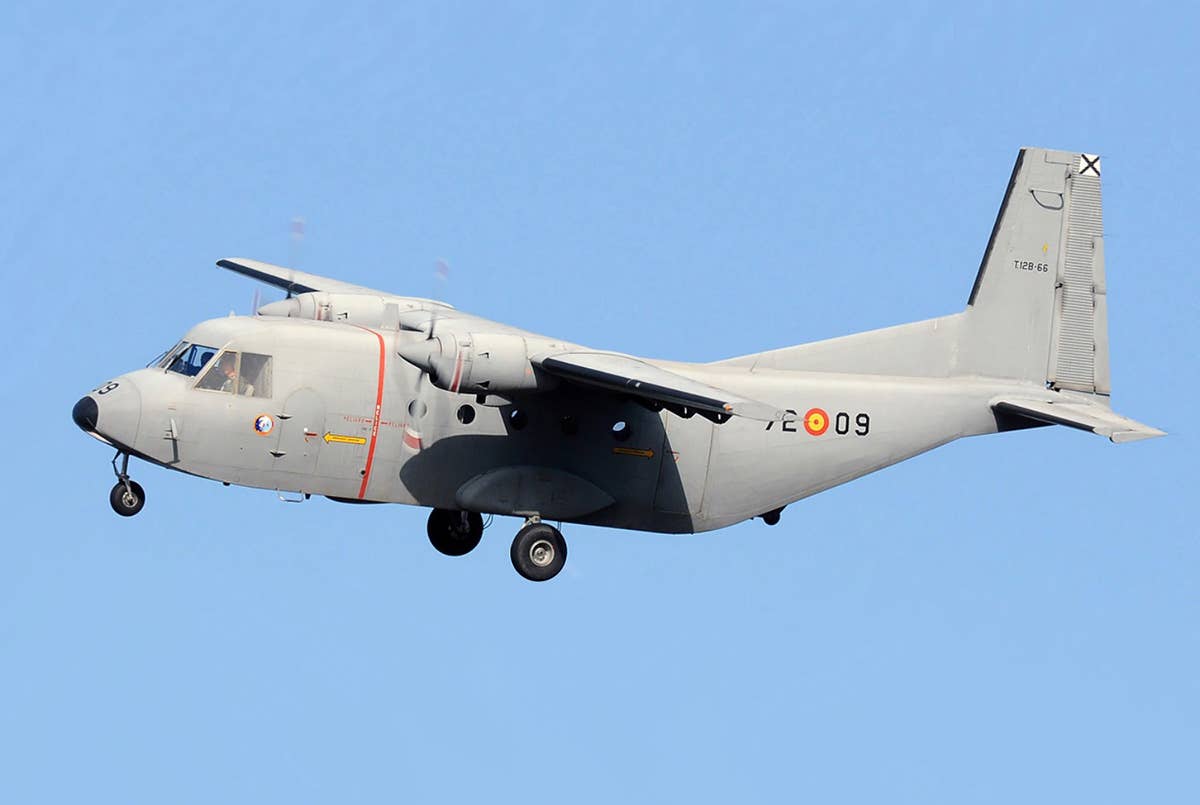NTSB Preliminary Report Sheds Light on Copilot Mid-Air Departure
Copilot ‘got up from his seat, removed his headset, apologized, and departed the airplane via the aft ramp door.’

The CASA 212 is a fixed-gear design with a ramp that lowers in the rear to allow for the egress of skydivers. [File Photo Courtesy: US Air Classics]
According to the National Transportation Safety Board, the copilot of a skydiving aircraft that made an emergency landing July 29 at Raleigh, North Carolina, intentionally departed the aircraft in flight without a parachute. According to the surviving pilot, the copilot was upset about the hard landing that damaged the airplane.
The report, released Tuesday, comes nearly three weeks after the CASA 212-200 was substantially damaged by a hard landing near Raeford, North Carolina.
According to the surviving pilot—who was acting as pilot-in-command (PIC)—they had flown two skydiving runs, then descended to Raeford West Airport (NR20) to pick up a third group of skydivers. The CASA 212 is a fixed-gear design with a ramp that lowers in the rear to allow for the egress of skydivers.
At the time of the accident, only the PIC and copilot—also known as the second-in-command (SIC) in the report—were on board.
The SIC was flying an approach that, according to the PIC, was “on heading, altitude and airspeed” at Raeford until the airplane descended below the tree line and the aircraft encountered an abrupt and uncommanded loss of altitude.
Both pilots called for a go-around, which the SIC initiated, but he was unable to prevent the aircraft from landing hard on the runway. The impact damaged the right main landing gear.
The PIC assumed the flight controls when the aircraft reached 400 feet agl and flew a low pass over the runway so airfield personnel could verify the damage, as the landing gear of the aircraft is not visible from the cockpit.
The personnel subsequently called the PIC to let him know that they had recovered the fractured landing gear on the runway.
The PIC directed the SIC to declare an emergency and request a diversion to Raleigh Durham International Airport (KRDU), some 78 nm away, for an emergency landing.
Crew Coordinated with ATC
According to the PIC, while en route to Raleigh, the crew coordinated with air traffic control operations and planned their approach and landing at KRDU. The SIC was responsible for communicating with air traffic control while the PIC flew the airplane.
In Live ATC recordings of conversations between the aircraft and air traffic controllers, a pilot aboard the CASA 212 (using the callsign “Shady 2”) is heard declaring an emergency, stating “We have lost our right wheel. We’d like to proceed to Raleigh and make the landing at Raleigh.”
ATC confirmed that Raleigh-Durham was the desired airport and advised Shady 2 to resume its own navigation to Raleigh-Durham.
ATC asked for information about the home base of the aircraft, how many people were on board, and the amount of fuel. The pilot’s transmission indicated there were two people on board and they had enough fuel for approximately four hours of flying.
Later in the transmission, ATC asked for verification that a wheel was missing from the aircraft as the result of a landing. The pilot replied, “affirmative.” Another voice replied, “the wheel assembly has been found.” A second voice from Shady 2 explained there was a hard landing and the aircraft went around “and at that point, we lost the wheel.”
A few minutes later, the controller supplied Shady 2 with the telephone number for Fayetteville Approach to call when they were on the ground. The next transmission was Shady 2 checking in as they passed through 3,500 feet.
Pilot: Copilot Became Visibly Upset
The PIC told investigators that there was moderate turbulence during the flight, and that about 20 minutes into the diversion, after conducting approach and emergency briefings, the SIC became visibly upset about the hard landing.
The PIC stated that the SIC then opened his side cockpit window and "may have gotten sick," and the PIC took over radio communications. The SIC then lowered the ramp in the back of the airplane indicating that he felt like he was going to be sick and needed air.
According to the NTSB report, the SIC "got up from his seat, removed his headset, apologized, and departed the airplane via the aft ramp door."
The PIC stated there was a bar one could grab about 6 feet above the ramp, but he did not see the SIC grab the bar before exiting the airplane.
Next, the PIC turned the airplane to the right to search for the SIC and notified air traffic control that his co-pilot had departed the airplane without a parachute.
The body of the SIC was found a short time later in the backyard of a home some 20 miles from the airport.
The PIC proceeded on course to KRDU, where he performed a low-approach and then emergency landing. The airplane departed the right side of the runway and came to rest upright in the grass. The PIC sustained minor injuries.
The post-accident examination of the airplane revealed substantial damage to the right main landing gear, the landing gear fittings, and the airframe structure where the fittings attach.

Sign-up for newsletters & special offers!
Get the latest FLYING stories & special offers delivered directly to your inbox






